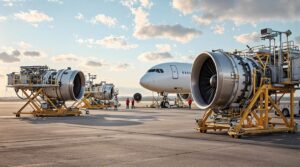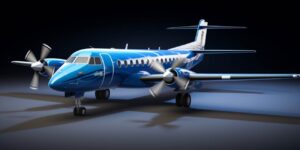Stepping into the cockpit is like entering a realm of control and responsibility. This specialized area, usually at the front of the plane, houses the pilots and essential instruments that transform a colossal metal structure into a graceful, soaring bird. The term cockpit itself conveys a sense of authority and expertise, where aviators harness the power of flight.
At the core of the cockpit experience is the connection between human intuition and cutting-edge technology. The front of the plane is a convergence point, where a seasoned flight crew collaborates seamlessly with advanced avionic systems. The cockpit is a theater of decisions, where split-second choices impact the trajectory of the entire journey.
Within the confines of the cockpit, a symphony of instruments orchestrates the airborne ballet. The control yoke, throttle, and myriad switches become extensions of a pilot’s body, translating intentions into graceful maneuvers. The front of the plane is not just a physical space; it’s a realm of expertise, where professionals master the art and science of flight.
Imagine the view from the cockpit, peering through the expansive windshield that frames the boundless sky. The front of the plane offers a panoramic vista, a privilege reserved for those entrusted with the noble duty of guiding passengers safely to their destinations. It’s a vantage point that transcends the ordinary, underscoring the significance of the cockpit in the grand tapestry of aviation.
Cockpit equipment – what is located on the front panel
Within the cockpit of an aircraft, the front panel is a crucial hub where a myriad of instruments and controls converge, ensuring the pilot has the tools needed to navigate the skies safely. Let’s delve into the main components adorning this pivotal section.
One central element on the front panel is the Primary Flight Display (PFD), a high-tech screen that presents critical information about the aircraft’s attitude, altitude, airspeed, and heading. This instrument serves as the pilot’s primary reference for maintaining control and situational awareness.
Adjacent to the PFD, the Navigation Display (ND) complements the pilot’s understanding of the aircraft’s position and route. It often displays navigation waypoints, airways, and the surrounding airspace. These displays, collectively known as the Electronic Flight Instrument System (EFIS), have become integral to modern cockpits, replacing traditional analog gauges.
Guiding the aircraft through the three-dimensional space is facilitated by the Control Display Unit (CDU). This interface allows the pilot to interact with the Flight Management System (FMS), enabling the input of waypoints, routes, and performance data. The integration of CDU with modern avionics has streamlined flight planning and execution.
Crucial for communication and navigation, the Communication and Navigation (Com/Nav) radios are prominent fixtures on the front panel. Pilots use these to establish contact with air traffic control, receive weather updates, and tune in to navigation aids. The integration of VHF (Very High Frequency) and HF (High Frequency) radios ensures effective communication over short and long distances.
The Autopilot Control Panel sits prominently, allowing the pilot to engage and manage the autopilot system. This panel permits adjustments to altitude, heading, and airspeed settings, providing a hands-free option for certain phases of flight. The autopilot has become an indispensable tool for reducing pilot workload during long-haul journeys.
Enhancing safety, the Weather Radar display is another critical component on the front panel. It provides real-time information about weather patterns, allowing pilots to navigate around hazardous conditions. The ability to anticipate and avoid turbulence, thunderstorms, and other adverse weather phenomena contributes significantly to passenger comfort and overall flight safety.
Completing the ensemble are the Engine Indication and Crew Alerting System (EICAS) displays. These monitors offer comprehensive information about the status of the aircraft’s engines, fuel systems, and other critical components. EICAS alerts pilots to any anomalies or malfunctions, enabling swift responses to maintain the integrity of the flight.
What does the copilot do in the cockpit
The copilot, also known as the first officer, plays a crucial role in the cockpit alongside the pilot. While both share the responsibility of safely navigating the aircraft, their duties are distinct yet complementary.
One of the primary duties of the copilot is to assist the pilot in executing various flight tasks. During takeoff and landing, the copilot collaborates closely with the pilot, handling communication with air traffic control and monitoring instruments. This division of tasks enhances efficiency and ensures that no critical detail is overlooked.
The responsibilities of the copilot extend beyond mere assistance. In the event of unexpected situations or emergencies, the copilot is trained to take immediate control of the aircraft. This readiness is a vital aspect of the copilot’s role, emphasizing their integral part in maintaining flight safety.
While the pilot focuses on navigation and decision-making, the copilot actively manages the aircraft’s systems. Monitoring fuel levels, engine performance, and navigation instruments are among the duties that ensure the copilot remains an indispensable asset throughout the flight.
Effective communication between the pilot and copilot is paramount. The copilot relays important information, executes checklists, and assists in interpreting air traffic control instructions. This seamless collaboration is essential for a smooth and well-coordinated flight operation.
Furthermore, the copilot plays a pivotal role in the pre-flight checks, contributing to a comprehensive assessment of the aircraft’s condition. This meticulous approach aligns with their overarching responsibility to contribute to a safe and secure flight environment.
Table:
| Task | Copilot | Pilot |
|---|---|---|
| Takeoff and Landing | Assists | Executes |
| Emergency Response | Takes Control | Focuses on Decision-making |
| System Management | Monitors | Manages |
| Communication | Relays Information | Receives Instructions |
In essence, the copilot is not merely a second-in-command but an indispensable partner to the pilot, sharing the intricate dance of flying an aircraft with finesse and precision.
Emergency procedures – what pilots do in case of failure
When cruising at high altitudes, pilots are well aware of the potential challenges that may arise, ranging from failure in aircraft systems to unforeseen emergencies. In such critical moments, a well-defined set of procedures and protocols become their guiding light, ensuring the safety of everyone on board.
Imagine a scenario where an engine failure occurs mid-flight. This isn’t just a theoretical concern; it’s a situation pilots train rigorously for. The first protocol involves swift communication with air traffic control, declaring an emergency to gain priority assistance. Meanwhile, the aircraft’s procedure manual becomes the focal point, providing a step-by-step guide to address the issue.
One crucial procedure in the event of an engine failure is the initiation of the aircraft’s auxiliary power unit (APU). Pilots quickly assess whether the APU can compensate for the lost power or if a controlled descent is necessary. This decision-making process, embedded in the protocol, demands precision and a rapid response.
In the cockpit, collaboration between the pilot and co-pilot is paramount. They follow a synchronized procedure checklist, which incorporates various emergency scenarios. The protocol dictates that each step is meticulously executed, from assessing the severity of the failure to implementing corrective actions.
When dealing with emergencies, communication extends beyond the cockpit. The cabin crew plays a vital role in implementing procedures that ensure passenger safety. From securing loose items to preparing for an emergency landing, their actions align with the broader protocol defined by the airline.
Consider the complexity of a sudden loss of cabin pressure—a potentially life-threatening emergency. The procedure involves the swift deployment of oxygen masks and a controlled descent to a safer altitude. This life-saving protocol is ingrained in the training of every pilot and cabin crew member.
Another facet of emergency preparedness revolves around the navigation system. In the rare instance of a failure in the primary navigation instruments, pilots switch to backup systems. This procedure, part of the aviation protocol, guarantees that even in the face of technical glitches, the aircraft remains on course.
To enhance clarity and adherence to these critical procedures, airlines often use tables outlining emergency scenarios and the corresponding protocols to be followed. These tables provide a quick reference, ensuring that pilots have immediate access to the necessary information when time is of the essence.






